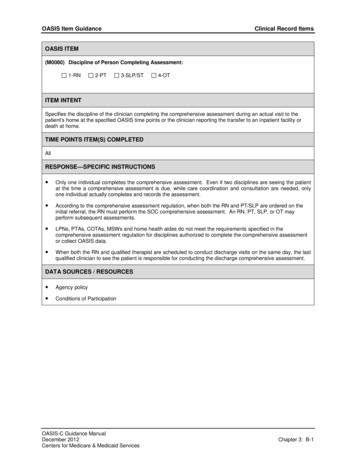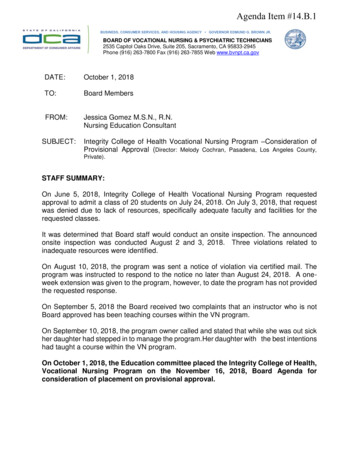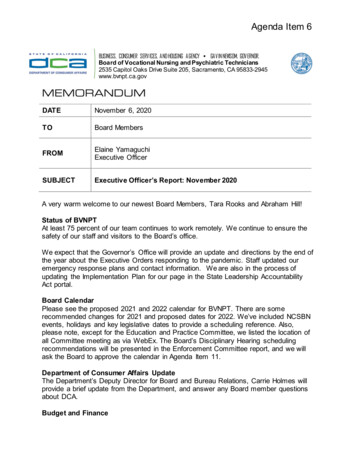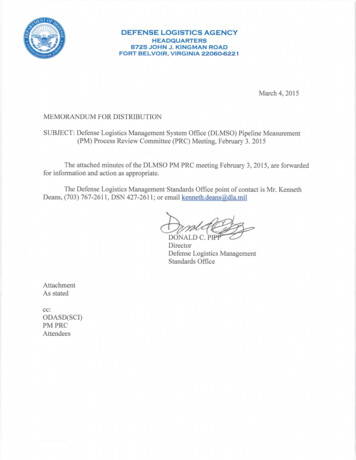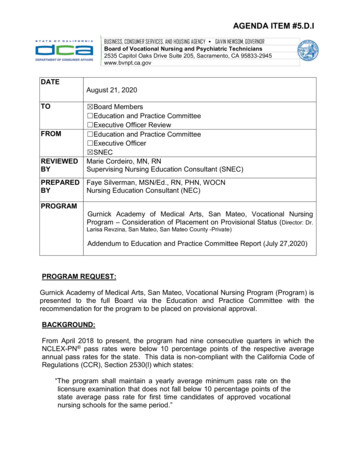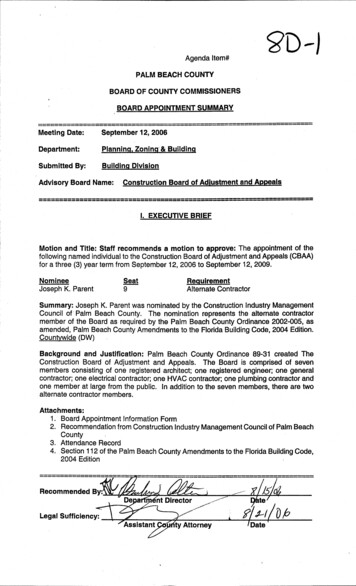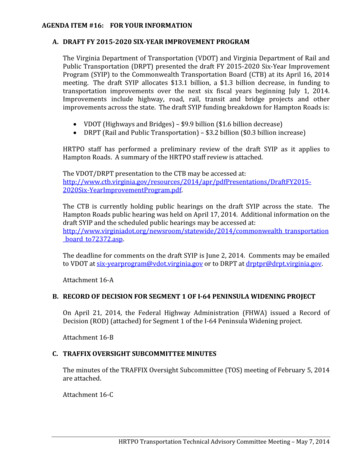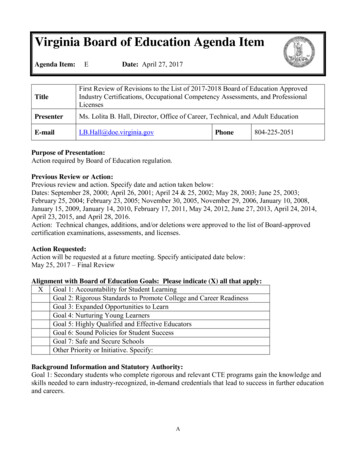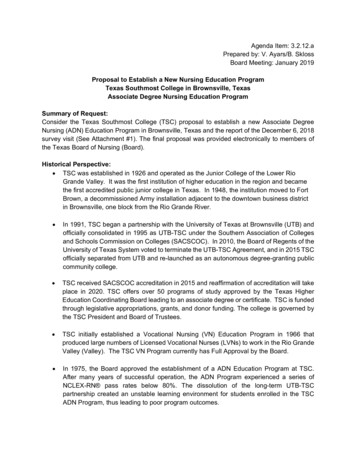
Transcription
Agenda Item: 3.2.12.aPrepared by: V. Ayars/B. SklossBoard Meeting: January 2019Proposal to Establish a New Nursing Education ProgramTexas Southmost College in Brownsville, TexasAssociate Degree Nursing Education ProgramSummary of Request:Consider the Texas Southmost College (TSC) proposal to establish a new Associate DegreeNursing (ADN) Education Program in Brownsville, Texas and the report of the December 6, 2018survey visit (See Attachment #1). The final proposal was provided electronically to members ofthe Texas Board of Nursing (Board).Historical Perspective: TSC was established in 1926 and operated as the Junior College of the Lower RioGrande Valley. It was the first institution of higher education in the region and becamethe first accredited public junior college in Texas. In 1948, the institution moved to FortBrown, a decommissioned Army installation adjacent to the downtown business districtin Brownsville, one block from the Rio Grande River. In 1991, TSC began a partnership with the University of Texas at Brownsville (UTB) andofficially consolidated in 1995 as UTB-TSC under the Southern Association of Collegesand Schools Commission on Colleges (SACSCOC). In 2010, the Board of Regents of theUniversity of Texas System voted to terminate the UTB-TSC Agreement, and in 2015 TSCofficially separated from UTB and re-launched as an autonomous degree-granting publiccommunity college. TSC received SACSCOC accreditation in 2015 and reaffirmation of accreditation will takeplace in 2020. TSC offers over 50 programs of study approved by the Texas HigherEducation Coordinating Board leading to an associate degree or certificate. TSC is fundedthrough legislative appropriations, grants, and donor funding. The college is governed bythe TSC President and Board of Trustees. TSC initially established a Vocational Nursing (VN) Education Program in 1966 thatproduced large numbers of Licensed Vocational Nurses (LVNs) to work in the Rio GrandeValley (Valley). The TSC VN Program currently has Full Approval by the Board. In 1975, the Board approved the establishment of a ADN Education Program at TSC.After many years of successful operation, the ADN Program experienced a series ofNCLEX-RN pass rates below 80%. The dissolution of the long-term UTB-TSCpartnership created an unstable learning environment for students enrolled in the TSCADN Program, thus leading to poor program outcomes.
At the January 19, 2017 Board meeting, the Board voted to withdraw approval from theTSC ADN Program, based upon four consecutive years of NCLEX-RN examination passrates falling below 80% and areas of noncompliance with Board Rule 215. The laststudent graduated in May 2017. After the program closed, many changes occurred in TSC Administration, the HealthProfessions Division, and the Nursing Department. Resultantly, there was a renewedcommitment by Administration and the Board of Trustees to establish a new ADNProgram. A first draft of the proposal was received in the Board office on June 21, 2018 and reviewedby Board Staff. Following Board Staff’s recommendations, a revised version was receivedon October 18, 2018. The proposal was deemed complete in November 2018, and a sitevisit was conducted on December 6, 2018 by Education Consultant Beverly Skloss, MSN,RN.Summary of Proposal:Overview of the Proposal: TSC proposes to establish a new ADN Program comprised of two tracks: a traditional orgeneric track and an LVN to ADN track. The generic track plans to enroll an initial cohortof 24 students in August 2019 and one cohort of 24 students in Spring 2020, while theLVN to ADN track would enroll an initial cohort of 10 students in Summer 2020. Bothtracks would graduate the first cohort, comprised of a total of 34 students, in May 2022. Each track consists of 60 semester credit hours (SCH). The generic ADN degree planand the LVN to ADN degree plan both contain 11 SCH of pre-requisites and 13 SCH ofgeneral education core courses. The generic ADN track has 36 SCH of nursing courses while the LVN to ADN track has20 SCH of nursing courses. The LVN to ADN students receive credit for 16 SCH of nursingcourses with proof of LVN licensure, as well as successful completion of RNSG 1327Transition to Nursing Practice and RNSG 2206 Clinical 1 Transition during their firstsemester of the program. Student-centered learning will be facilitated through face-to-face instruction, along withfaculty supervised hands-on clinical experiences in a variety of local health care settingsin Brownsville and Harlingen. Clinical contracts have been secured with the followingfacilities: Valley Regional Medical Center Brownsville, Valley Baptist Medical CenterBrownsville, Harlingen Medical Center, Rio State Grande Center, Spanish Meadows, andthe Early Childhood Center at TSC.Rationale and Need for the Program: As a community college, TSC serves one of the nation’s most racially and economicallydiverse populations, many of whom are medically underserved. The proposal sets forth
that the current lack of nursing education programs in Cameron County is compoundingthe significant nursing shortage, with obvious consequences for health outcomes forValley residents. These conditions support the critical need for an increased number ofregistered nurses (RNs), prepared and committed to providing care to persons living inthe Valley, and the opportunity for TSC to fill that need. The ADN Program will be delivered at the International Technology, Education andCommerce Center (ITECC) on the TSC campus in Brownsville. Currently, no genericADN program is available in Cameron County. In the Valley, Texas State TechnicalCollege – Harlingen offers a VN Program and an LVN to ADN Program and South TexasCollege in McAllen offers a VN Program, an LVN to ADN Program, and a generic ADNProgram. At the October 2018 Board meeting, Rio Grande Valley College in Pharr wasapproved to establish an LVN to ADN Program. The University of Texas Rio GrandeValley (UTRGV) located in Edinburg offers a Baccalaureate Degree Nursing (BSN)Program. Three large acute care hospitals that were surveyed projected a need of 25-40 additionalRNs per hospital per year during the next five years. Three long-term care facilities, alllocated in Brownsville, responded that they employ 81 nurses, and have four openpositions among them. A mental health institution in Harlingen, providing both in-patientand out-patient services, stated it employs 25 nurses, has one open position, and projectsneeds for RNs in the next five years. Letters of support verified that the nursing needs in the Valley continue to increase andclinical facilities communicated enthusiastic support for the proposed ADN Program, aswell as their ability to provide clinical learning experiences and employment ongraduation. Eleven letters of support are included in the proposal documents.Administration and Organization: In January 2017, the TSC Board of Trustees unanimously approved hiring a nursingconsultant to begin the process of establishing an ADN Program. In January 2018, TSChired a full-time ADN Program Director to work with the consultant on developing the ADNProgram proposal. Dr. Jesus Roberto Rodriguez, President of TSC, officially notified theTexas Board of Nursing on February 15, 2018 of the college’s intent to seek approval toopen the ADN Program, demonstrating administrative support. The proposal states that the start-up budget for the first two years of the ADN Programwill be supported by TSC. All students enrolled in the nursing program will be required topay tuition and student fees. The ITECC, where the nursing program will be housed with the other health professionsprograms, is owned by TSC and its operations including administration, utilities, groundskeeping, custodial services, and security are paid by TSC central administration. TSCprovides fiscal support for centralized services, such as information technology,
communications, human resources, student services, and institutional advancement.Adequacy of fiscal resources is reviewed annually during the budget process with thedeans of all divisions within TSC. The proposal presents a budget for the first two years of operation to include director,faculty, and staff salaries. Additionally, funds to utilize and upgrade existing buildings(classrooms and simulation/skills lab) were provided. Other budgeted items includeExamSoft testing software, HESI, Shadow Health, and simulation/skills lab supplies. Beth Kasprisin, MSN, RN is the Program Developer/Director of the proposed ADNProgram. Ms. Kasprisin has had experience in academia since 2008 after she receivedher Master’s Degree in Nursing (MSN) with an emphasis in nursing education. Beforecoming to TSC, Ms. Kasprisin served in various coordinator roles in nursing education,including a level coordinator, a clinical coordinator, and Director of Nursing for anotherADN Program in Texas.Faculty: The ADN Program would require a total of 3.6 full-time employees (FTEs) in the firstacademic year, and a total of 8.5 FTEs in the second and third academic year. Five nurseshave expressed a desire to teach in the ADN Program at TSC and they all meet theminimum requirements in Board Rule. These prospective nursing faculty members areadequate to meet teaching needs in the first year. Recruiting qualified faculty will take place in multiple ways. The ADN Program Directorwill work with the TSC Human Resources Department to place advertisements for facultypositions in nursing job search engines (i.e., Indeed), and nursing websites. Anotherrecruitment strategy will be to contact universities that offer MSN degrees to speak withtheir students about possible job opportunities upon graduation. Nearby UTRGV offersan MSN in Nursing Education, and will be a primary source for recruitment of qualifiednursing faculty.Students: The TSC ADN program anticipates a beginning cohort of 24 students for the traditionalADN program track and 10 LVN to ADN track students. Admission into the TSC ADN Program will be reviewed and screened through a selectionprocess. The traditional ADN track applicants will be reviewed bi-annually, and the LVNto ADN track applicants will be reviewed annually. Between January and October 2018, the ADN Program Director received approximately150 email inquiries regarding enrolling in the ADN Program. Approximately 50 studentswent to the Department of Nursing to inquire about the application process and to set upa plan for application in August 2019. These individuals are currently in the process ofcompleting pre-requisite courses.
As TSC currently has a successful VN program, recent graduates and current VN studentswill be recruited for the new ADN Program. TSC LVN Program alumni from the last threeyears were surveyed to assess student interest and qualifications to enter the proposedLVN to ADN track. These data show TSC could admit 10 LVN to RN students in theproposed ADN Program to enroll in Summer 2020. TSC currently has existing partnerships with local school districts offering dual enrollmentcourses. The nursing program will utilize these relationships to recruit students for theADN Program. Further, student recruitment will come from the South Texas Academy forMedical Professions High School in Olmito, Texas, a high school that specializes in earlyhealth care degree placement.Program of Study: The generic track can be completed in six semesters, and the LVN to ADN track can becompleted in five semesters, including all pre-requisites. The ADN Program meets thestate requirements of the Workforce Education Course Manual in terms of allowablecombinations of lecture, lab, clinical, and semester hours. Generic track students will be admitted in the fall and spring semesters. The LVN to ADNtrack students will be admitted only once a year in the summer semester and bridge withthe generic students for their third and fourth semesters. The mission and philosophy of the ADN Program is congruent with that of TSC as theprogram prepares students for success in their nursing career. The program operateswithin the mission of TSC, subscribing to the college core values of integrity, access,service, excellence, innovation, and success. The curriculum provides structured learning opportunities to prepare graduates for fourroles: member of the profession, provider of patient-centered care, patient safetyadvocate, and member of the health care team. The focus is the patient, the community,and the promotion of health. The educational environment is non-threatening andnurturing to encourage learning, decision-making, and critical thinking skills that meet orexceed program objectives and outcomes. Learning in the TSC ADN Program correlates with student learning outcomes (SLOs) thatorganize the curriculum, guide instructional delivery, and direct learning activities in clinicaland theory courses. The philosophy of the nursing program reflects the faculty’s beliefsassociated with the development of a graduate nursing student and identifies theDifferentiated Essential Competencies (DECs) and the Quality and Safety Education forNurses (QSEN) standards. The curriculum supports the integration of both the DECs andQSEN within the SLOs, along with the Accreditation Commission for Education in Nursing(ACEN) ADN Competency Standards.
To ensure quality contact hours for student learning in the application of theory to clinicalpractice, the contact ratio for clinical is 1:3. Clinical courses in the second and thirdsemesters include combination specialty clinical hours to support Mental Health,Obstetrics, and Pediatrics didactic courses. The ADN curriculum has both Texas core courses and BSN pre-requisite courses built into allow students an easier transition into a BSN Program. The sequence of theADN Program allows students to take summer courses towards BSN requirements whileno ADN nursing courses are in session. TSC has begun discussion with universities to set up articulation agreements for TSCgraduates to enter an RN to BSN Program upon graduation. UTRGV offers an online RNto BSN, and has agreed to begin developing an articulation agreement with TSC thissummer. Texas A&M College of Nursing has had several discussions with TSC leadershipabout establishing an articulation agreement once outcomes are demonstrated for thenew ADN Program.Clinical Learning Experiences: The TSC ADN Program has secured appropriate sites for clinical rotations. The proposedclinical sites have stated that they are willing and able to accommodate students eachsemester without this having an impact on the current use of the facility by existingprograms. Clinical contracts have been secured with the following facilities: Valley Regional MedicalCenter, Rio Grande State Hospital, South Texas Rehabilitation Hospital, Valley BaptistMedical Center, and Harlingen Medical Center. The proposed ADN Program will not utilize preceptors at the clinical agencies. Faculty willremain with the students each clinical day and facilitate student learning in collaborationwith the clinical staff. Simulation may be incorporated in each clinical rotation as a clinical make-up day, to lowerthe number of students at a clinical site, or during didactic class activities. Simulation willaccount for no more than 20% of the clinical time each semester.Facilities, Resources, and Services: The TSC Health Professions Programs, including the ADN and LVN Programs, arehoused in the ITECC at 301 Mexico Blvd in Brownsville. The building is spacious, withroom for future expansion as needed. The Central Plaza offers approximately 10,000square feet for events and functions, such as the pinning ceremony. The space where theHealth Professions Division is located, as it is currently configured, meets ADN Programdelivery needs.
The Nursing Department has its own main office with spaces for the ADN Program Directorand the VN Program Director. The two programs share an administrative assistant, whooffices between the director offices. The administrative assistant supports studentinquiries and admissions, program needs, and administrative requests of both ProgramDirectors. This administrative assistant will continue to support both programs during thefirst two years of program operation. The fully implemented ADN Program, with approximately 116 nursing students by the endof the second year, will require 8.5 full-time faculty members (director and faculty forfundamental skills and assessment, women’s health, pediatrics, adult health, older adulthealth, and mental health). There are eight nursing faculty offices located in the samehallway, four of the offices are currently filled with VN Program faculty, and there are fouroffices for new ADN faculty. Additional offices within the Health Professions Division areavailable as more ADN faculty are hired. Eighteen classrooms on the ITECC can be utilized for nursing theory lectures. Allclassrooms have a podium with a computer and audio-visual capabilities to projectinformation from the computer to a screen during class. The Health Professions Divisionhas a breakroom/lounge for students, faculty, and staff to utilize, furnished with arefrigerator and microwave as well as tables and chairs. Bathrooms are convenientlylocated at the end of the hallway from the nursing skills labs, as well as next to thebreakroom/lounge in the Health Professions Division. All areas meet the Americans withDisabilities Act requirements for accessibility. The ITECC, where nursing and the other healthcare programs are located, has a labwhere students learn skills and clinical decision-making in simulated clinical scenarios withhigh-fidelity mannequins. Having other healthcare disciplines using the same space willfacilitate opportunities for interprofessional learning, especially in simulation. Students willhave the ability to reserve lab space for additional clinical skills practice on their own time. The skills lab includes a 10-bed hospital lab, with various bed styles to provide theopportunity for students to experience operating different models. Each hospital bed isequipped with air and suction regulators and canisters. Oxygen is simulated but has actualoxygen flow meters and tubing. Each bed has an over-the-bed table, bedside table,hospital curtain, and intravenous infusion pole. Further, each bed has a glove dispenserwith hand sanitizer. The beds are set up to illustrate an actual hospital room for studentsto practice nursing skills throughout the program. Eight of the beds have mannequins withvarying degrees of simulation capacity. The ADN skills lab can also function as a classroom and hold approximately 30 studentsfor a lecture. The podium is equipped with computer and screen for transmitting visualmaterials, and a whiteboard to facilitate lectures.
The Health Professions Division has a four-bed Simulation Center, and a two-bedEmergency Room, open to all programs in the division. High-fidelity mannequins include:ALS Sim Man, Sim Junior, and Sim Mom. One room in the Simulation Center is left openfor a standardized patient or mannequin, depending on the scenario. The EmergencyRoom also has high-fidelity mannequins and headwalls to simulate the hospitalenvironment. The Emergency Room was designed to replicate a community hospital inBrownsville. The headwalls in the Emergency Room are equipped with oxygen, suction,and air capabilities. Further, there is a full crash cart for both adult and pediatric simulationexperiences. The Simulation Center contains four private rooms, with an open area in the middle tosimulate a nurses’ station. Faculty can control and record the simulations behind a twoway mirrored glass window, by speaking and operating the mannequins based on studentinteractions. TSC Student Services are centralized under the Office of the Vice President for StudentServices. Comprehensive “one-stop-shopping” for enrollment, financial aid disbursement,bill payment, and international services is provide
Jan 03, 2019 · LVN to ADN track. These data show TSC could admit 10 LVN to RN students in the proposed ADN Program to enroll in Summer 2020. TSC currently has existing partnerships with local school districts offering dual enrollment courses. The nursing program will utilize the


